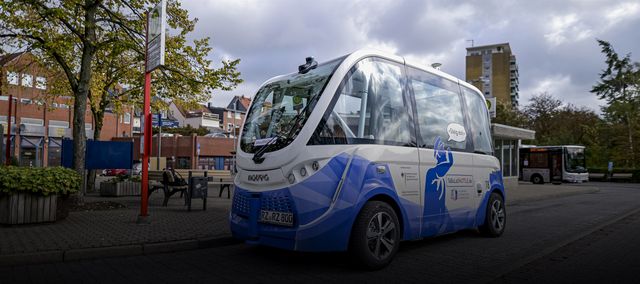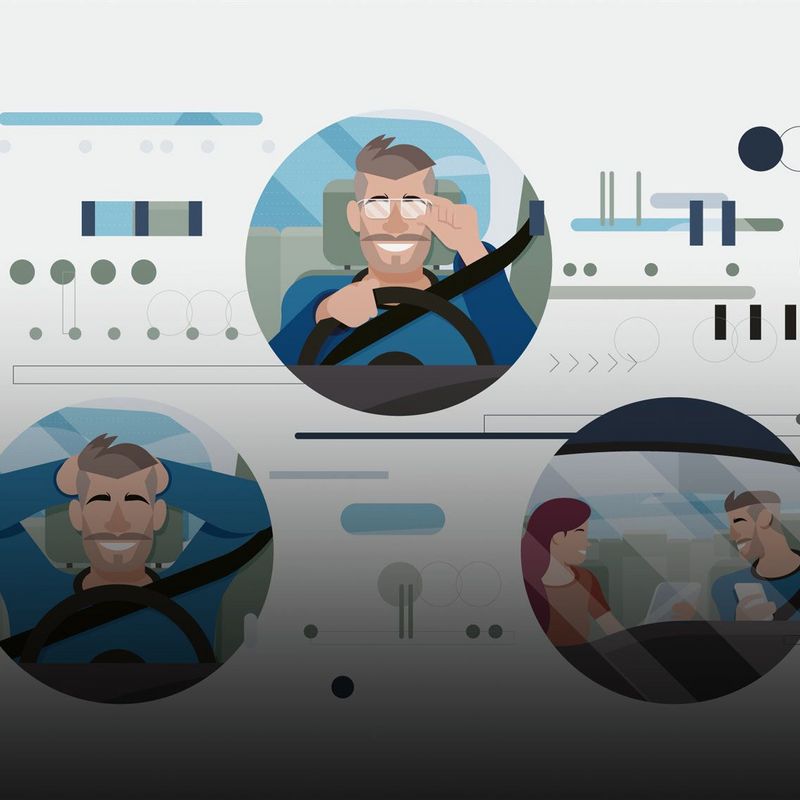28 November 2019
A robot bus has been whizzing through the streets of the village of Keitum on the island of Sylt since April; the “Hubi Shuttle” was launched in Osnabrück in October; and the first passengers from the small town of Lauenburg an der Elbe were able to take their seats in the self-driving “TaBuLa-Shuttle” early in the same month. Before the automated buses were allowed onto the road, they were examined by Klaus W. Baumeister and his colleagues. In this interview, the expert from TÜV NORD explains how he goes about testing these kinds of automated shuttle buses.
#explore: Mr Baumeister, how do you inspect an automated bus?
Klaus W. Baumeister: You have to take a great many things into account before a vehicle of this kind is allowed out onto the road. In an ideal world, we will go out right at the start to inspect the proposed route with representatives of the operator, the manufacturer and the town or city. Because it’s here that the first problems to be solved will come to light: for instance, whether hedges along the road are likely to present an obstacle for the bus and will need to be trimmed. The shuttles haven’t yet managed to drive around hedges. They’re programmed to stop as soon as their sensors detect an obstacle. Inspecting the route also reveals whether a speed limit will need to be introduced over a section of it to ensure that there won’t be too great a discrepancy in speed between the buses, which are currently limited to 18 km/h, and other road users. More significant changes may also be needed at the same time. For example, the Hubi-Shuttle in Osnabrück was originally intended to turn left onto a busy road, but, since the vehicle wasn’t yet able to do this, the route was just reversed to eliminate this particular manoeuvre.
„Auch wenn der Bus automatisiert fährt: Es ist immer ein Sicherheitsfahrer an Bord, der sogenannte Operator.“
What happens next?
In a second step, we carry out an individual assessment to check the vehicle for technical safety in manual driving mode. After all, even if the bus is supposed to drive itself, there’s always a safety driver, or operator, on board who’s ultimately responsible and needs to be able to steer or stop the vehicle at all times. At our Institute for Vehicle Technology and Mobility in Hanover or some other recognised test site, we check the manufacturer's documentation. We measure and weigh the vehicle, test the braking behaviour and drive it around our test site in different weather conditions, such as rain and wind or even at night, to find out, for example, whether reflections arise in the dark which might impair the operator’s ability to see properly. We also enact failure scenarios. For example, we might simulate a sensor failure to test whether the vehicle goes into “safe mode” as it’s programmed to do and, if necessary, initiates immediate braking.
What is the legal basis for the registration of these automated buses?
In principle, these vehicles are registered under national law in the context of a particular exemption. As they currently don’t travel faster than 18 kilometres per hour, they aren’t subject to the EU rules that govern other motor vehicles. However, there are also requirements of domestic road traffic law in Germany that these vehicles don’t meet: For example, they don’t have a steering wheel or a mechanical service brake, but are instead controlled by a joystick and braked electrically. Nonetheless, agreement has been reached in Germany that vehicles with these features can still be approved under certain circumstances. In order to ensure that every expert in Germany is working according to the same standards, the VdTÜV has teamed up with the Länder authorities to develop guidelines which list and describe these exceptions and their requirements.
How do you go about testing the automated driving functions?
The automated driving functions can only be deployed on a route which has previously been measured by sensors. The vehicle is first driven manually along a particular route so that its sensors, which may use GPS, radar or lidar technology, can familiarise themselves with the terrain. Everything is recorded in the first instance: a house corner, an advertising pillar or a woman crossing the road with a dog. These data are then cleaned up in a mainframe computer. After all, the woman won’t walk there every day, whereas the pillar and the house corner will be constants. Based on these data, the manufacturer will develop a program which the vehicle can use to find its way around on this specific route – following a virtual rail. We then conduct a test drive on the actual route to demonstrate that the vehicle is behaving as it should. When we do this, we’re guided by the guidelines I mentioned earlier which set out in detail the traffic scenarios the vehicle has to be able to master. We usually drive the route several times: If, for example, someone’s using a zebra crossing and the vehicle stops, we can tick this point off on the list. But if no one happens to be crossing the road, we’ll go around again until the situation we want has occurred and we’ve finally been able to test all the required traffic scenarios. Based on my observations during the test drive, the shuttle dataset will be reconfigured by the operator and defined in my presence. And it will only be possible to operate the bus later on using the dataset with this exact date and time. The exemption which has been granted must specifically name the dataset in question and also contain a drawing of the route with a highly detailed blow-by-blow account of the programmed drive. Where does the vehicle go and how fast? When does an emergency stop take place? Any adjustments made by the operator will need a new dataset and, if necessary, a new evaluation by us.
„Die automatisierten Fahrfunktionen können nur auf einer vorher eingemessenen Route erfolgen. Dazu wird das Fahrzeug zunächst manuell über eine Strecke bewegt, lernt durch seine Sensoren, etwa GPS, Radar oder Lidar, den Weg kennen.“
When might this be the case?
In one example, the vehicle in Lauenburg wasn’t yet able to recognise a traffic light. So we had to specify an emergency stop during the evaluation. In other words, the vehicle stopped automatically and the driver activated it again as soon as the traffic light turned green. The infrastructure was put in place to allow the vehicle to communicate with the traffic lights so that it could manage this section of the route independently. The operator created a new dataset, and we made sure it was working correctly out on the actual route.
Four years ago, you inspected the first robot shuttle. How has the technology evolved since then?
As far as its drive system is concerned, the vehicle in Lauenburg is a further development of the shuttle used on Sylt. Since the island is flat, only one axle needs to be driven. In Lauenburg, on the other hand, the bus also has to cope with inclines, which is why two axles are motorised. The sensors have also improved enormously in recent years. The first generations of the vehicles needed fixed guide points at a height of about three metres. In other words, although the shuttle was easily able to recognise a house wall, open stretches of road between villages were beyond it, as there were simply no orientation points. The latest-generation sensors can now also identify road markings and detect objects that are less than three metres high. In principle, this means they can also be used on other routes. As far as the projects themselves are concerned, there has also recently been a trend towards an ever-increasing degree of difficulty with regard to the driving and traffic situations the vehicles need to be able to manage. In its third and final stage of development, the course in Lauenburg will include a very wide range of traffic scenarios, including sections on a trunk road, narrow streets, cobblestones, inclines and gradients of up to 16 percent. With this challenging course, the aspiration is for Lauenburg to become a test centre where manufacturers can put vehicles through their paces. But even there, the vehicle still has to run on a preset virtual rail. The next big step would be for the automated shuttles to be able to overtake other vehicles on their own. This is already possible in some places in the motorway. But in urban settings road markings are often less clear, and the traffic situation is much more complex. Which explains why it’s inevitably going to take some time for the buses to be able to get around parked cars on their own.
You may also like
ZUR PERSON
Klaus W. Baumeister is an officially recognised motor vehicle expert at TÜV NORD Mobilität in Hanover.


